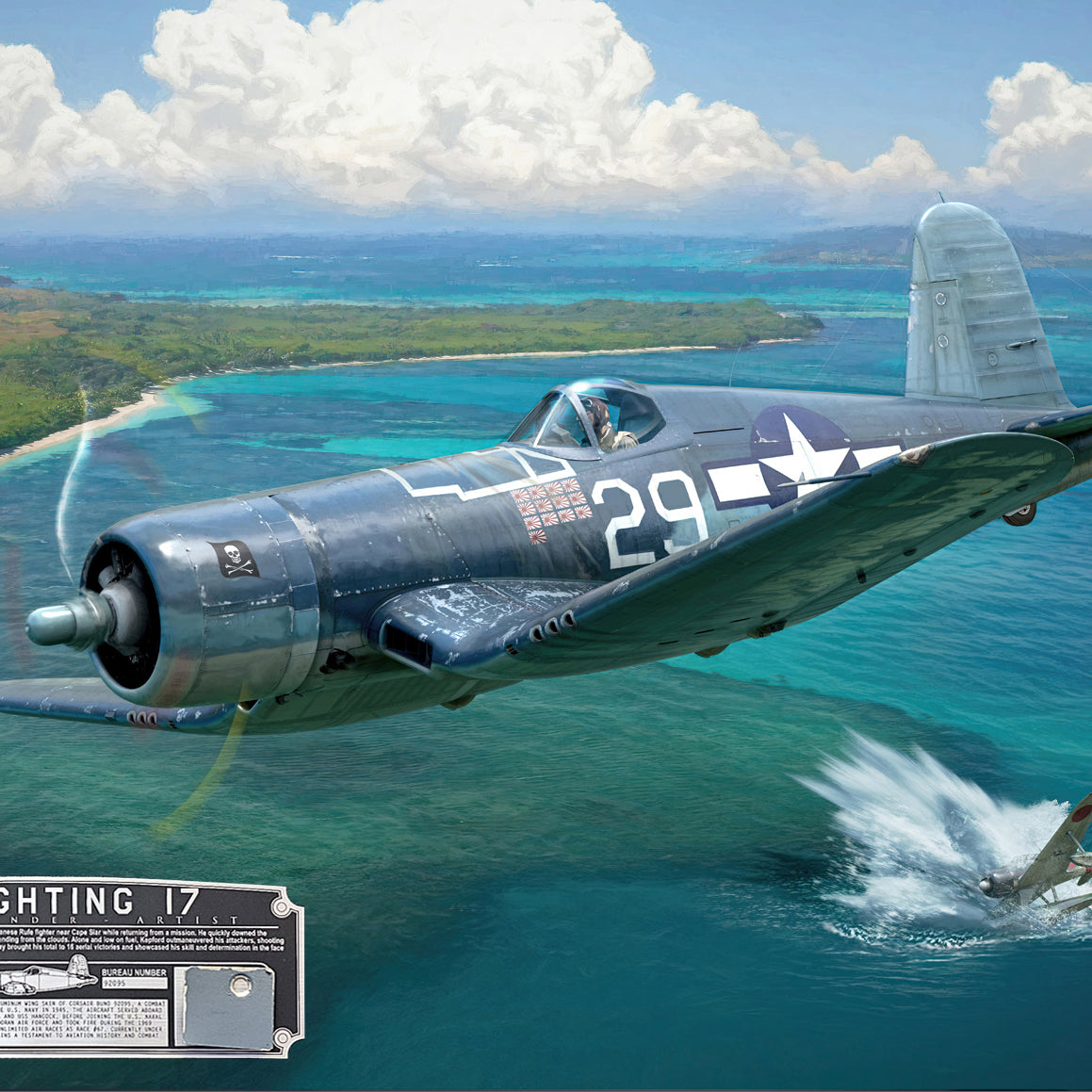A Hero’s Triumph: Ira “Ike” Kepford’s Legendary Mission on February 19, 1944
February 19, 1944, etched itself into the annals of aviation history with a mission that showcased the bravery, skill, and determination of Ira “Ike” Kepford, the highest scoring ace of Fighting Squadron 17 (VF-17). On this fateful day, Kepford faced overwhelming odds, outmaneuvered deadly foes, and returned victorious, marking one of the most dramatic air battles of the Pacific theater.
The inspiration for the print "Fighting 17"
The day’s operation began like many others for VF-17, with an escort mission over the volatile skies near St. George Channel. Kepford, leading a high-cover division, was tasked with ensuring the safety of TBF Avengers striking targets near Cape St. George. However, his mission took a fateful turn when his wingman experienced engine trouble and was forced to abort. Left without a wingman—a dangerous predicament for any pilot—Kepford continued his duty until the strike group reached its target.

Artist, Craig Tinder, showcasing a strip of original Corsair wing painted in tri-tone camouflage
As he turned for home, Kepford spotted something below: a Japanese Rufe seaplane cruising low over the water. The temptation was irresistible. Kepford descended on the lone fighter, delivering a short, devastating burst that sent the Rufe flaming into the ocean. But his victory would come at a steep price.
A Lone Pilot vs. 20 Zekes
Kepford’s moment of triumph quickly turned perilous. Out of the clouds at 16,000 feet descended a formidable force of Japanese Zekes—at least 20 in total. Four of the enemy fighters broke away and pursued him relentlessly. Alone, low on fuel, and deep in enemy territory, Kepford faced the unthinkable odds with the poise of a true ace.

'White 29' F4U Corsair
Over the radio, a desperate cry for help reached the ears of his squadron mates: “Skipper! Skipper! This is Ike! Ike! Three have me boxed. I’m headed north.” But help was impossible. The rest of VF-17 was fully committed to their escort duties, and Kepford’s fate was uncertain. The squadron could only hope for a miracle.
The Return of “White 29”
Hours passed, and hope waned. Exhaustion gripped the squadron as they speculated about Kepford’s fate. Then, out of the sunset, his F4U Corsair, marked with the number “29,” taxied onto the airstrip. Cheers erupted as the squadron ran to meet Ike. Kepford, pale and drenched in sweat, emerged from his cockpit with help from a crewmate and raised three fingers in triumph. Against all odds, he had downed three Zekes and escaped to fight another day.
 Lt. Ira C. Kepford in front of his F4U Corsair 'White 29'
Lt. Ira C. Kepford in front of his F4U Corsair 'White 29'
His Corsair bore many scars from of battle, but Kepford had returned with his tally of aerial victories increased to sixteen. His feat was nothing short of extraordinary. Many would later remark that such heroism merited the Congressional Medal of Honor. Instead, Kepford was awarded the Silver Star.
About the Relic:
This aluminum fragment, once part of the starboard wing of a Goodyear-built FG-1D Corsair, Aircraft No. 92095, tells a story of service spanning decades and two significant conflicts. The wing panel, removed during restoration in 2022, came from the bottom of the starboard wing directly from the where American Star emblem resides and was provided to Aces In Action in order to complete a commission art piece to commemorate its historical journey. In fact, during the majority of the aircraft's static museum display, she was painted in the livery of VF-17's "Ruthless II", flown buy Navy Ace Oscar Chenowith, Jr. - a squadron mate to Ira "Ike" Kepford.
About Corsair 92095
First taken into service by the United States Navy in April 1945, Corsair No. 92095 was assigned to Bombing Fighting Squadron 80 (VBF-80) aboard the USS Boxer (CV-21) during the final months of World War II. Known for its rugged design and powerful performance, the F4U Corsair played a pivotal role in both air-to-air combat and ground attack missions in the Pacific theater.
After the war, in 1957, the aircraft was transferred to the Salvadoran Air Force (Fuerza Aérea Salvadoreña) and redesignated FAS-220 as part of the U.S. Military Assistance Program. This Corsair saw combat once again during the 1969 Football War (also known as the Soccer War), a brief conflict between El Salvador and Honduras. On 14 July 1969, Salvadoran forces, including FAS-220, attacked Honduran airfields using a mix of aircraft, including P-51 Mustangs and C-47 Skytrains. The Corsair was involved in these operations and even sustained minor anti-aircraft fire damage to its port wing.
Following its military service, Corsair No. 92095 was placed on static display at the Evergreen Air Museum. In recent years, it has been undergoing restoration at Airpower Unlimited in Jerome, Idaho, to return the aircraft to flying status. This relic, preserved from the original airframe, serves as a testament to the Corsair’s enduring legacy, from the Pacific battles of WWII to its role in a 20th-century regional conflict.
To purchase or see similar items, visit here.
Commissioned by Museums, Treasured by Collectors





Share:
TADLUR and the Story behind "Through Danger Let Us Ride"
The Legendary King Tiger Tank, The Story Behind "Panzer Ace"